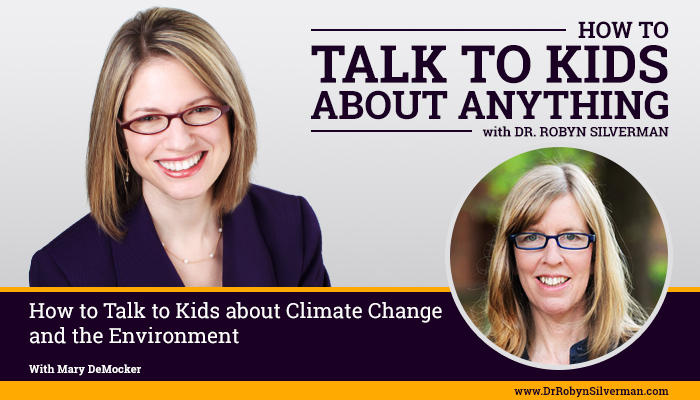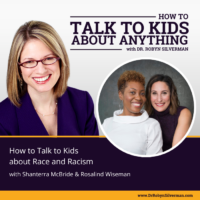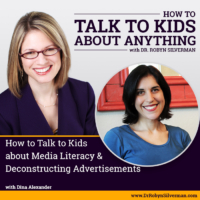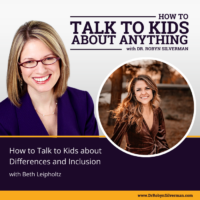Podcast: Play in new window | Download
Subscribe: Apple Podcasts | RSS | More
How to Talk to Kids about Climate Change and the Environment
This podcast will focus on how we can talk to kids about climate change and the environment. How can small changes in our everyday lives make a big difference? The podcast helps us to understand what is happening, good and bad, on a global scale, and how we can help our kids to become more knowledgeable about, more sensitive to and more active in helping the Earth. There is still hope and we can make an important impact on our climate, on the animals, on our natural resources and on the Earth as a whole—which, in turn, will help us all lead healthier, more connected lives.
I remember, as a child, learning that you turn off the faucet while brushing your teeth. You close the refrigerator quickly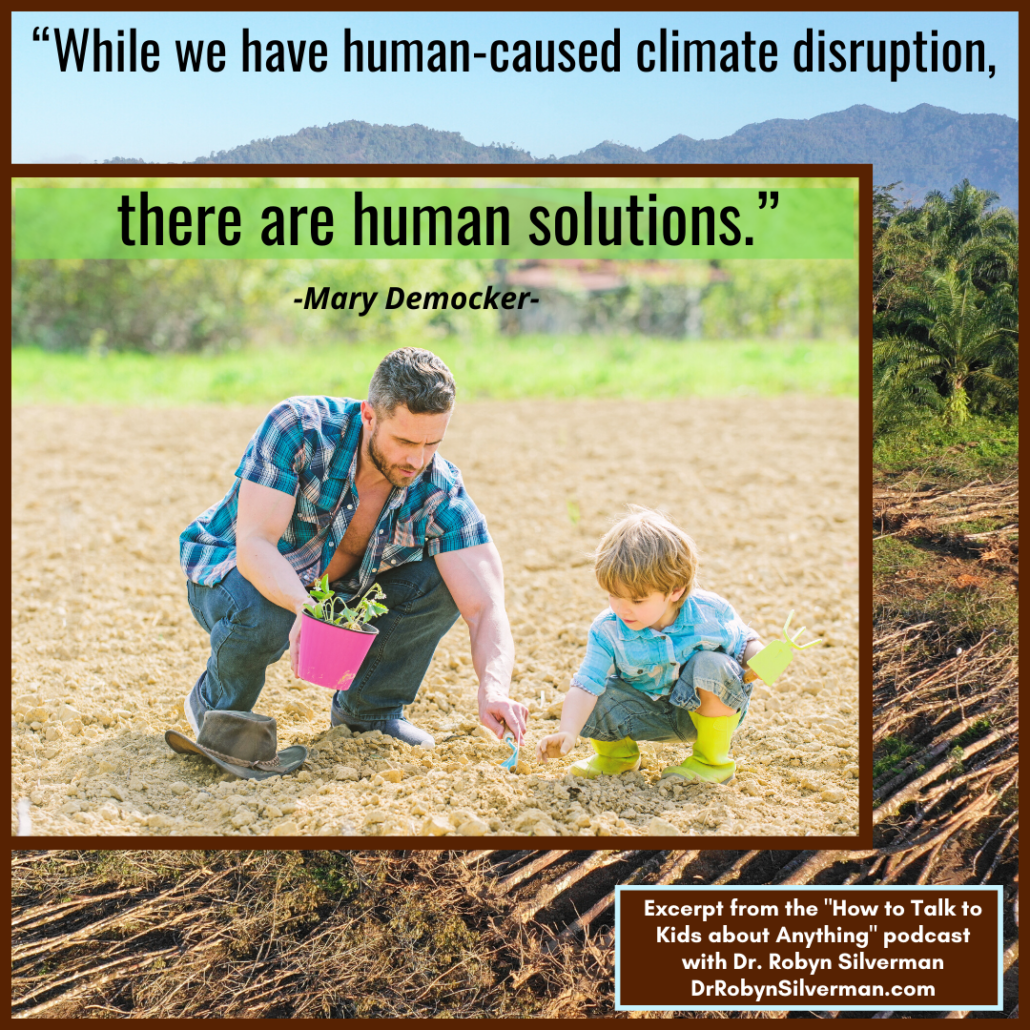 and turn off the lights when you leave the room—little things- and they needed to be taught because otherwise, I admit, I hadn’t thought much about leaving the tap on, standing in front of the open fridge for minutes figuring out what I wanted to eat or leaving on the lights in every conceivable room. I’ve needed to teach it to my kids too- but of course, they sometimes forget. Sometimes protecting the Earth isn’t the first thought that comes to mind when you’re standing in the shower, letting the hot water fall on your head and back. For some, climate change might feel distant- like something happening elsewhere but not right here at home. Although this seems to be changing a bit- many families, all over the world have found that climate change has begun to touch their lives.
and turn off the lights when you leave the room—little things- and they needed to be taught because otherwise, I admit, I hadn’t thought much about leaving the tap on, standing in front of the open fridge for minutes figuring out what I wanted to eat or leaving on the lights in every conceivable room. I’ve needed to teach it to my kids too- but of course, they sometimes forget. Sometimes protecting the Earth isn’t the first thought that comes to mind when you’re standing in the shower, letting the hot water fall on your head and back. For some, climate change might feel distant- like something happening elsewhere but not right here at home. Although this seems to be changing a bit- many families, all over the world have found that climate change has begun to touch their lives.
Deadlier wild fires, increasingly crazy weather, additional information of melting ice caps on the nightly news- information coming to us through news anchors as well as out of the mouths of younger and younger activists that are demanding awareness and action. My own children have quoted information from Weird But True books and nature documentaries about what’s going on with the polar bears and tropical forests. The truth is, we are all feeling the effects and we are all contributing to the effects of climate change– AND we are also able to help solve the problem. Of course, this means we must have the discussions that can bring about the change. It starts with opening our mouths and our hearts so that we can lay it all on the table. How do we give our children the facts about climate change- from discussions of fossil fuels to fluctuating animal habitats to sustainable and destructive energy sources so that they are in the know? And how can we, as families, alter how we live our lives, in small consistent ways, that will help create a healthier future for our loved ones? We need a climate revolution—and it starts at home, with us.
Our special guest today is Mary Democker. Mary DeMocker’s book, The Parents’ Guide to Climate Revolution: 100 Ways to Build a Fossil-Free Future, Raise Empowered Kids, and Still Get a Good Night’s Sleep is a finalist for the 2019 Oregon Book Award and has been featured on Yale Climate Connections and recommended on NPR and in The New York Times. Mary writes and speaks widely about parenting in a changing climate, helping parents, educators, clinicians, and young people find a positive role in the global transition to a clean energy future. She lives in Eugene, Oregon with her husband and sometimes her son, a freshman in college. His sister older graduated from college last year and is a teacher.
The podcast provides:
- What are kids afraid of when it comes to climate change?
- What is climate change?
- What is fracking?
- What can we do about these problems?
- What simple changes can we make in our homes that can help the environment?
- How can we get the children involved?
- How can reducing palm oil, planting trees, biking more, being out in nature more, composting or shopping at thrift stores help the environment?
- Can we make a difference?
Important Messages:
- Fears of kids: Where am I going to go if my house catches fire? Is this going to happen to me? (Thousands of kids have
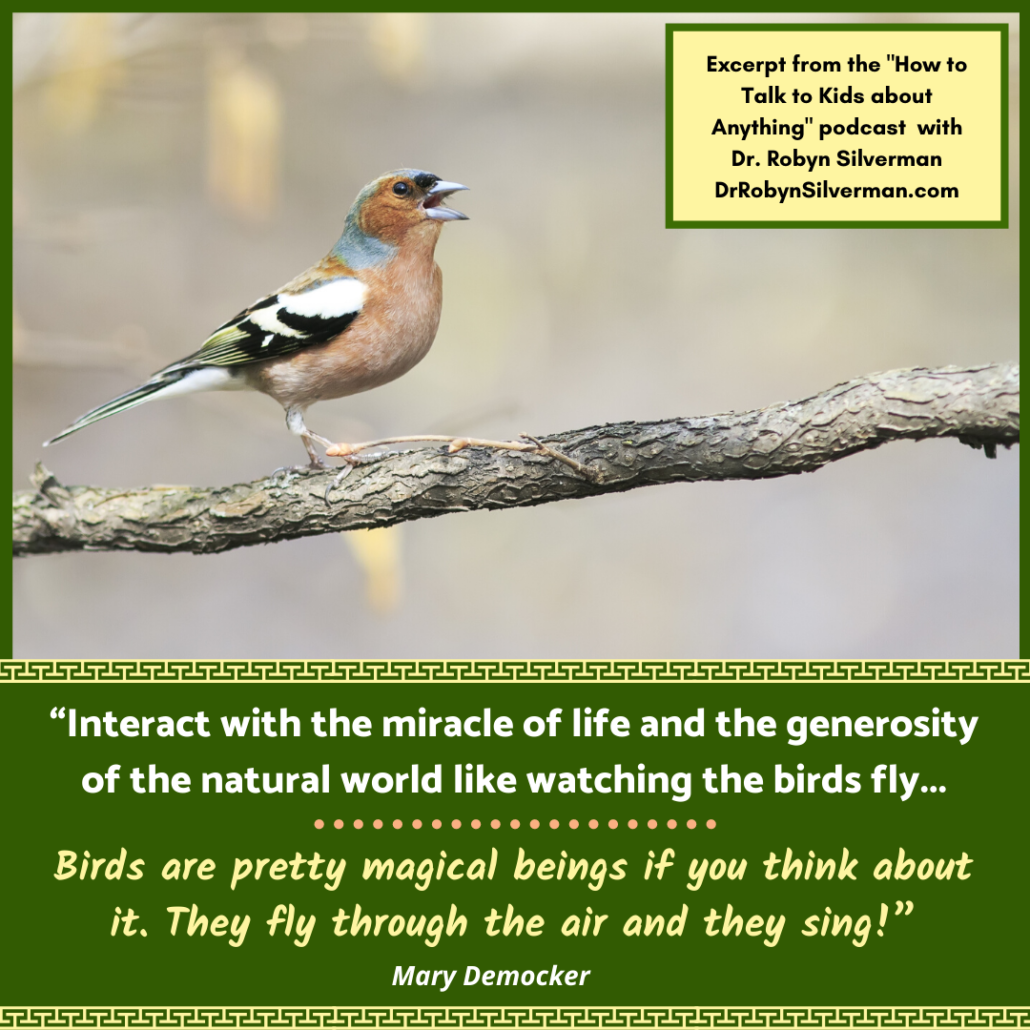 lost their homes to fires/floods in the last few years). Where are all the animals going to go when we keep taking their homes? Don’t adults care about fixing the climate?
lost their homes to fires/floods in the last few years). Where are all the animals going to go when we keep taking their homes? Don’t adults care about fixing the climate? - What is climate change? Young child: People are polluting. That pollution is creating blanket over the Earth. It’s warming it up. This is a problem because it’s changing the weather and where the animals and plants can live.
- Carbon can be brought back down to Earth and locked down into the trees and Earth.
- Check out her 4-page graphic-novel-style explanation of climate change on Mary’s website and in her book.
- Fracking: “In the past, people drilled into the Earth for natural gas and it was easier to get until about 10 years ago. We use it in our appliances. Now, people drill far into the Earth and it’s cracking the Earth and releasing methane gas. Methane is just as bad for the environment as carbon- it’s a poison for our environment. The chemicals from fracking is getting into the water.
- Older kids need to understand. So much water is being used to frack! Millions of gallons of water. Put into perspective long showers. Some industries are using millions of gallons of water to do something that isn’t good for the Earth.
- How can we get our family involved in pairing down our own ways we are causing problems with climate change—or be part of the solution? For example, cut food waste by 20 or 25%. “What sounds fun to you?” Composting? Civic action? Meatless Mondays? Keep it small at first- then celebrate successes. Cut driving one or two days per week. Buy only used clothes for back to school shopping? (You get a lot more for your money).
- Reduce food waste: Don’t throw away food that is perfectly good. Date stamps are often arbitrary. Guestimations. Dairy/Meat- use your nose and eyes! Also, try to use the food in a way that is new and different- make a meal from what we already have. Third, you can check the contents of your fridge with an app when you are at the store so you don’t double buy.
- Going on a search for palm oil products in the house: Pal oil products are destructive to the environment. In tropical countries – important tropic forests are being slashed and then pal oil plantations are being plated in their place. The demand is rising. We are cutting down important forests that are storing massive amounts of carbon, we are also seeing that they are burning those fires and releasing carbon. Some of these fires are burning for years. Devastating. Orangutans and other animals are being forced to extinction every time a tropical forest is slashed and burned. The Orangutans don’t have anywhere to go. They are dying and suffering at an alarming rate. We need to find different ways to eat and shop so we are no part of that devastation. Have a scavenger hunt. How much palm oil is in your cosmetics? Processed foods? Ice cream? Dog food? Shampoos?
- Planting trees: Lots of fun for young people. Low cost, low tech solution to the climate crisis. Like a scrubber! Gives shade, soil stability, water retention, wildlife habitat and cleans our pollution!
- Thrift store shopping: Becoming more conscious of “trends.” A sense we need to have “more.” Important to have the clothes we need in life BUT aware of the Earth. How much do we really need? A lot of the clothes with microfiber- when washed, put micro pellets of plastics into our oceans. Be mindful of what clothes you are buying. Thrift stores- better for environment. Plus the production of all these clothes is a lot on the environment. Some companies are trying to find sustainable fabrics and look at how their products are impacting the environment. And don’t forget the packaging and shipping. All effect climate.
- If you can bike and have a bike-riding town, this can be fun and good for community and kids and climate.
- Electric car- half the impact. Still has an impact. Better but not perfect.
- We need to think of cradle to grave production and how it impacts pollution and climate.
- Children need to be moving more. What’s going on? Screens. Stranger danger.
- Sedentary life style. Nature deficit disorder.
- Get connected with nature. Belonging. We need to care. We need to play. Immerse. Joy. Listen to birds. Look up and see the leaves changing. Miracle! Strawberries growing. Interaction with life. Joy and care.
- Have a relationship with our Earth- our home. Let’s garden it, let’s weed, let’s clean up after ourselves, let’s take care of the animals, let’s put out a humming bird feeder, let’s plant butterfly bushes. Let’s support anything that gives animals a good habitat and allows forests to grow. And let’s really say yes to a clean air, clean water, clean soil and know what that looks like.
- Show your kids so that they can be part of it. Compost together. Recycle. Rescue worms from puddles with your child. Leave campsites better than you found it. Pick up after selves. Pick up litter. Write letters. Protest signs. Civics becomes part of our stewardship and our community.
- Top tip: We can make a big difference. We have a window of time that we can change things around.
Notable Quotables:
- “While we have human-caused climate disruption, there are human solutions.”
- “There is so much water to frack. Millions of gallons of water. We might be worried about how long our shower was- and while we need to take care of making sure that we aren’t using too much water or wasting it, we have to notice that some industries are using millions of gallons of water to do something that isn’t healthy for the Earth. It’s important to know how much water is being used to extinction by fracking.”
- “To get your children involved in helping the environment from home, ask them; ‘what sounds fun to you?’ Do you want to try composting? Meatless Mondays? Civic action? Keep it small at first and celebrate successes.”
- “Every time one of those beautiful tropical rain forests– this living, breathing ecosystem–is slashed and a monoculture, like palm oil plantations, are being planted in its place, our orangutans and other animals are really suffering and dying at an alarming rate. We need to find different ways to eat and shop so we are not part of that devastation.”
- “Planting trees are a low cost, low tech solution to the climate crisis. They suck in the pollution we put out into the atmosphere like an atmospheric scrubber machine. They offer shade, wildlife habitats, soil stability, water retention. Anyplace we can put trees and plants is good for that environment and it’s good for our climate because it cleans our pollution.”
- “In general, every time you have a brand-new product, there’s going to be an impact on our climate and our oceans and on our atmosphere in terms of pollution and waste because all of those products are packaged and transported and put in heated storage and then packaged in bags when you take them home. We need to be aware of how clothing has become a climate issue because of the way they are being produced and shipped all over the world.”
- “When we consider the environment, we want to think of cradle to grave, the pollution each of our products is making from beginning to end of its life cycle.”
- “We tend to act on the behalf of the things we care about.”
- “Birds are pretty magical beings if you think about it. They fly through the air and they sing!”
- “Interaction with the miracle of life, the gift of life and the generosity of the natural world- watching the birds fly through the air, seeing the leaves changing, planting strawberries and seeing the first shoots of grass come up—it is important for children’s well-being on the planet and sense of joy and care of the planet that sustains their lives.”
- “Having that relationship with our Earth- our home- I call it the big yes. Let’s garden it, let’s weed, let’s clean up after ourselves, let’s take care of the animals, let’s put out a humming bird feeder, let’s plant butterfly bushes. Let’s support anything that gives animals a good habitat and allows forests to grow. And let’s really say yes to a clean air, clean water, clean soil and know what that looks like. Show your kids so that they can be part of it.”
- “We can make a big difference. We have this window of time right now and we can turn things around. There are things we can do and there is hope. We can slash our emissions, plant new forests and to change how we live on the planet. It’s an exciting time to be alive and to raise kids. But we need to help our kids understand what’s good for the planet is also good for them. They are not alone. We can do things together.”

